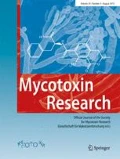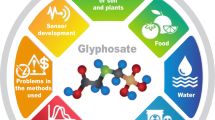Abstract
Deoxynivalenol (DON) is one of the most commonly found mycotoxins across the world, and it mainly contaminates staple food crops. This study aims to evaluate the dietary exposure of DON and to provide a geographical profile of DON exposure in China. The concentrations of DON and its acetylated derivatives in 15,004 cereal samples (10,192 wheat flour, 1750 maize meal, 892 oat flakes, and 2170 polished rice) were collected from 30 provinces, autonomous regions, or municipalities across China during 2010–2017, through a national food safety risk surveillance system. The consumption data for cereals were obtained from China National Nutrition and Health Survey in 2002, and 67,923 respondents from the same 30 regions were included in the analysis. Among all the cereals considered, the concentration was the highest in wheat flour, with the mean concentration of 250.8 μg/kg. Applying a worst-case scenario, some individuals were possibly at risk, but the probability of acute effects was low. The mean and median exposure for the entire population was 0.61 and 0.36 μg/kg bw/day, respectively, below the (PM) TDI, indicating an acceptable overall health risk in Chinese population. Wheat contributed to 86% of the total DON exposure. Significant discrepancy was observed between the exposure and the contamination of DON. The high-exposure cluster area was in northern China, whilst the most seriously contaminated regions were all located in the southeast, which formed a seriously contaminated area.




Similar content being viewed by others
References
Ali N, Blaszkewicz M, Degen GH (2016) Assessment of deoxynivalenol exposure among Bangladeshi and German adults by a biomarker-based approach. Toxicol Lett 258:20–28
Assunção R, Martins C, Vasco E, Jager A, Oliveira C, Cunha SC, Fernandes JO, Nunes B, Loureiro S, Alvito P (2018) Portuguese children dietary exposure to multiple mycotoxins - an overview of risk assessment under MYCOMIX project. Food Chem Toxicol 118:399–408
Cui L, Selvaraj JN, Xing F, Zhao Y, Zhou L, Liu Y (2013) A minor survey of deoxynivalenol in Fusarium infected wheat from Yangtze–Huaihe river basin region in China. Food Control 30:469–473
Dong F, Qiu J, Xu J, Yu M, Wang S, Sun Y, Zhang G, Shi J (2016) Effect of environmental factors on Fusarium population and associated trichothecenes in wheat grain grown in Jiangsu province, China. Int J Food Microbiol 230:58–63
EFSA – European Food Safety Authority, Panel on Contaminants in the Food Chain (2017) Scientific opinion on the risks to human and animal health related to the presence of deoxynivalenol and its acetylated and modified forms in food and feed. EFSA J 15:4718. https://doi.org/10.2903/j.efsa.2017.4718
Faeste CK, Pierre F, Ivanova L, Sayyari A, Massotte D (2019) Behavioural and metabolomic changes from chronic dietary exposure to low-level deoxynivalenol reveal impact on mouse well-being. Arch Toxicol 93:2087–2102
Fang J, Jianhong X, Xin L, Xianchao Y, Jianrong S (2014) Natural occurrence of deoxynivalenol and zearalenone in wheat from Jiangsu province, China. Food Chem 157:393–397
Heyndrickx E, Sioen I, Huybrechts B, Callebaut A, De Henauw S, De Saeger S (2015) Human biomonitoring of multiple mycotoxins in the Belgian population: results of the BIOMYCO study. Environ Int 84:82–89
Li L, Rao K, Kong L, Yao C, Xiang H, Zhai F, Ma G, Yang X, The Technical Working Group of China National Nutrition and Health Survey (2005) A description on the Chinese national nutrition and health survey in 2002. Chin J Epidemiol 26:478
JECFA – Joint FAO/WHO Expert Committee on Food Additives (2011) Safety Evaluation of Certain Contaminants in Food: Seventy-second Meeting of the Joint FAO/WHO Expert Committee on Food Additives, 2011
Ji F, Xu J, Liu X, Yin X, Shi J (2014) Natural occurrence of deoxynivalenol and zearalenone in wheat from Jiangsu province, China. Food Chem 157:393–397
Kamala A, Kimanya M, Lachat C, Jacxsens L, Haesaert G, Kolsteren P, Ortiz J, Tiisekwa B, De Meulenaer B (2017) Risk of exposure to multiple mycotoxins from maize-based complementary foods in Tanzania. J Agric Food Chem 65:7106–7114
Kettler S, Kennedy M, McNamara C, Oberdörfer R, O'Mahony C, Schnabel J, Smith B, Sprong C, Faludi R, Tennant D (2015) Assessing and reporting uncertainties in dietary exposure analysis: mapping of uncertainties in a tiered approach. Food Chem Toxicol 82:79–95
Marin S, Ramos AJ, Cano-Sancho G, Sanchis V (2013) Mycotoxins: occurrence, toxicology, and exposure assessment. Food Chem Toxicol 60:218–237
Milani JM (2013) Ecological conditions affecting mycotoxin production in cereals: a review. Veterinã rnã Medicãna 58:405–411
Miller JD (2016) Changing patterns of fungal toxins in crops: challenges for analysts. J AOAC Int 99:837–841
Mishra S, Srivastava S, Dewangan J, Divakar A, Kumar Rath S (2020) Global occurrence of deoxynivalenol in food commodities and exposure risk assessment in humans in the last decade: a survey. Crit Rev Food Sci Nutr 60:1346–1374
Papageorgiou M, Wells L, Williams C, White K, De Santis B, Liu Y, Debegnach F, Miano B, Moretti G, Greetham S, Brera C, Atkin SL, Hardie LJ, Sathyapalan T (2018) Assessment of urinary deoxynivalenol biomarkers in UK children and adolescents. Toxins (Basel) 10:50
Payros D, Alassane-Kpembi I, Pierron A, Loiseau N, Pinton P, Oswald IP (2016) Toxicology of deoxynivalenol and its acetylated and modified forms. Arch Toxicol 90:2931–2957
Pestka JJ (2010) Deoxynivalenol: mechanisms of action, human exposure, and toxicological relevance. Arch Toxicol 84:663–679
Pestka JJ, Smolinski AT (2005) Deoxynivalenol: toxicology and potential effects on humans. J Toxicol Environ Health B Crit Rev 8:39–69
Rocha MEBD, Freire FCO, Maia FEF, Guedes MIF, Rondina D (2014) Mycotoxins and their effects on human and animal health. Food Control 36:159–165
Sakshi M, Kausar MA, Premendra DD, Haushila PP, Mukul D (2013) Occurrence of deoxynivalenol in cereals and exposure risk assessment in Indian population. Food Control 30:549–555
Schothorst RC, van Egmond HP (2004) Report from SCOOP task 3.2.10 “collection of occurrence data of Fusarium toxins in food and assessment of dietary intake by the population of EU member states”. Subtask: trichothecenes. Toxicol Lett 153:133–143
Selvaraj JN, Zhao Y, Sangare L, Xing F, Zhou L, Wang Y, Xue X, Li Y, Liu Y (2015) Limited survey of deoxynivalenol in wheat from different crop rotation fields in Yangtze-Huaihe river basin region of China. Food Control 53:151–155
Shi J, Liu X, Qiu J, Ji F, Xu J, Dong F, Yin X, Ran J (2014) Deoxynivalenol contamination in wheat and its management. Sci Agric Sin 47:3641–3654
Silva MV, Pante GC, Romoli J, de Souza A, Rocha G, Ferreira FD, Feijó A, Moscardi S, de Paula KR, Bando E, Nerilo SB, Machinski M Jr (2018) Occurrence and risk assessment of population exposed to deoxynivalenol in foods derived from wheat flour in Brazil. Food Addit Contam Part A Chem Anal Control Expo Risk Assess 35:546–554
Srey C, Kimanya ME, Routledge MN, Shirima CP, Gong YY (2014) Deoxynivalenol exposure assessment in young children in Tanzania. Mol Nutr Food Res 58:1574–1580
Stoev SD (2013) Food safety and increasing hazard of mycotoxin occurrence in foods and feeds. Crit Rev Food Sci Nutr 53:887–901
Sundheim L, Lillegaard IT, Fæste CK, Brantsæter AL, Brodal G, Eriksen GS (2017) Deoxynivalenol exposure in Norway, risk assessments for different human age groups. Toxins (Basel) 9:46
Van der Fels-Klerx HJ, Olesen JE, Madsen MS, Goedhart PW (2012) Climate change increases deoxynivalenol contamination of wheat in North-Western Europe. Food Addit Contam Part A Chem Anal Control Expo Risk Assess 29:1593–1604
Van der Fels-Klerx HJ, Van Asselt ED, Madsen MS, Olesen JE (2013) Impact of climate change effects on contamination of cereal grains with deoxynivalenol. PLoS One 8:e73602
Wang XD, Liang J, Cao P, Zhou S, Wu AB, Gao P, Xu HB, Liu ZP, Gong YY (2019a) Biomonitoring study of deoxynivalenol exposure in Chinese inhabitants. Int J Environ Res Public Health 16:2169
Wang XD, Yang X, Xu HB, Cao P, Gao P, Liang J (2019b) Exposure status and health risk assessment of deoxynivalenol from cereals in Chinese population in different regions. Zhonghua Yu Fang Yi Xue Za Zhi 53:394–397
Wu QH, Wang X, Yang W, Nüssler AK, Xiong LY, Kuča K, Dohnal V, Zhang XJ, Yuan ZH (2014) Oxidative stress-mediated cytotoxicity and metabolism of T-2 toxin and deoxynivalenol in animals and humans: an update. Arch Toxicol 88:1309–1326
Xiao G, Hu Y, Ning L, Yang D (2018) Spatial autocorrelation analysis of monitoring data of heavy metals in rice in China. Food Control 89:32–37
Funding
This research and the APC were funded by China Food Safety Talent Competency Development Initiative (CFSA 523 Program).
Author information
Authors and Affiliations
Corresponding authors
Ethics declarations
Disclaimer
The funders had no role in the design of the study; in the collection, analyses, or interpretation of data; in the writing of the manuscript, or in the decision to publish the results.
Conflict of interest
The authors declare that they have no conflict of interest.
Additional information
Publisher’s note
Springer Nature remains neutral with regard to jurisdictional claims in published maps and institutional affiliations.
Rights and permissions
About this article
Cite this article
Wang, X., Yang, D., Qin, M. et al. Risk assessment and spatial analysis of deoxynivalenol exposure in Chinese population. Mycotoxin Res 36, 419–427 (2020). https://doi.org/10.1007/s12550-020-00406-8
Received:
Revised:
Accepted:
Published:
Issue Date:
DOI: https://doi.org/10.1007/s12550-020-00406-8




